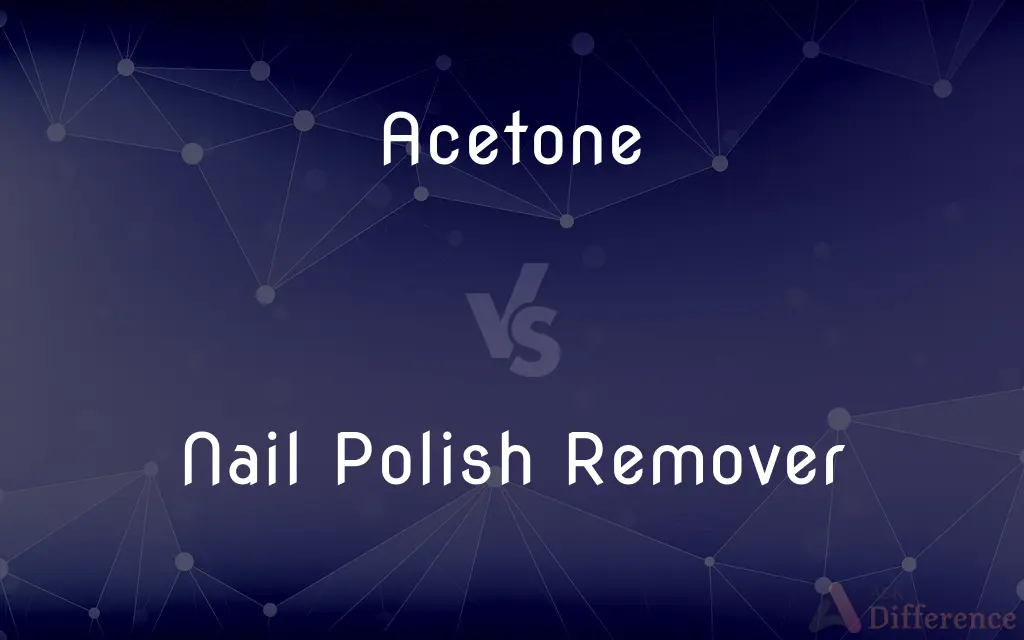Acetone vs. Nail Polish Remover — What's the Difference?
By Tayyaba Rehman — Published on January 10, 2024
Acetone is a volatile, flammable solvent, often used as the main ingredient in many nail polish removers.

Difference Between Acetone and Nail Polish Remover
Table of Contents
ADVERTISEMENT
Key Differences
Acetone is a colorless, volatile, and flammable organic solvent, chemically classified as a ketone. It is known for its effectiveness in dissolving various organic compounds, including nail polish. Nail polish remover is a product specifically designed to remove nail polish from nails and can contain acetone as a primary ingredient, but it often includes other additives such as oils, fragrances, and coloring agents.
In terms of composition, acetone is a simple compound with the formula CH₃COCH₃, used in various industrial and laboratory settings beyond cosmetic applications, such as in paint thinners and cleaners. Nail polish remover, while it may contain a high concentration of acetone, also includes additional substances that are meant to nourish the skin, minimize the harshness of the solvent, and improve the user experience.
The effectiveness of acetone in removing nail polish is due to its strong solvent properties, which quickly break down and dissolve the polish. Some nail polish removers are acetone-free, using less aggressive solvents like ethyl acetate or isopropyl alcohol, which are gentler on the skin and nails but might be less effective or slower in removing certain types of nail polish.
While acetone is widely used in nail polish removers, its strong solvent nature can be drying to the skin and nails, which is why additional conditioning agents are often added in commercial nail polish removers. These formulations aim to mitigate the drying effects while still effectively removing nail polish.
In summary, acetone is a powerful organic solvent used in a variety of applications, including as a primary component in many nail polish removers. Nail polish remover, however, is a formulated product designed specifically for cosmetic use, often containing acetone along with other ingredients to improve its efficacy and reduce its potential drying effects.
ADVERTISEMENT
Comparison Chart
Chemical Classification
Organic solvent (ketone)
Cosmetic removal product
Composition
Pure chemical compound CH₃COCH₃
Acetone with additives (oils, fragrances)
Primary Use
Solvent in industrial, lab, cosmetic applications
Specifically designed to remove nail polish
Effect on Skin and Nails
Can be drying and harsh
Often includes conditioners to minimize dryness
Effectiveness
Highly effective solvent
Varies based on formulation
Compare with Definitions
Acetone
Acetone is used as a solvent in industries and labs.
Acetone is effective in cleaning laboratory glassware.
Nail Polish Remover
Nail polish removers often contain acetone as a key ingredient.
This nail polish remover contains acetone, which quickly removes polish.
Acetone
Acetone is a volatile organic solvent.
Acetone evaporates quickly when exposed to air.
Nail Polish Remover
Nail polish removers often include conditioners for nail health.
This nail polish remover also contains aloe and vitamin E for nail conditioning.
Acetone
Acetone is colorless and has a distinctive smell.
The strong odor in nail polish removers is often due to acetone.
Nail Polish Remover
Nail polish remover is a product designed to remove nail polish.
I used nail polish remover to clean off the old polish from my nails.
Acetone
Acetone is a flammable liquid.
Special care must be taken when handling acetone due to its flammability.
Nail Polish Remover
Nail polish removers can be acetone-free, using alternative solvents.
She prefers using an acetone-free nail polish remover to protect her nails.
Acetone
Acetone can dissolve many organic compounds.
Acetone is used to dissolve plastic and resins in industrial applications.
Nail Polish Remover
Nail polish removers vary in effectiveness based on their formulation.
This brand of nail polish remover works well even on glitter polishes.
Acetone
A colorless, volatile, extremely flammable liquid ketone, C3H6O, widely used as an organic solvent. It is one of the ketone bodies that accumulate in the blood and urine when fat is being metabolized.
Acetone
(organic compound) A colourless, volatile, flammable liquid ketone, (CH3)2CO, used as a solvent.
Acetone
A volatile liquid consisting of three parts of carbon, six of hydrogen, and one of oxygen; pyroacetic spirit, - obtained by the distillation of certain acetates, or by the destructive distillation of citric acid, starch, sugar, or gum, with quicklime.
Acetone
The simplest ketone; a highly inflammable liquid widely used as an organic solvent and as material for making plastics
Common Curiosities
What is acetone?
Acetone is a volatile, flammable organic solvent often used in nail polish removers.
Can acetone be used on its own to remove nail polish?
Yes, pure acetone can effectively remove nail polish.
Is acetone harmful to skin and nails?
Acetone can be drying and harsh to skin and nails with prolonged exposure.
What are the alternatives to acetone in nail polish removers?
Alternatives include ethyl acetate and isopropyl alcohol.
What is nail polish remover?
Nail polish remover is a product formulated to remove nail polish, often containing acetone.
Are all nail polish removers acetone-based?
No, there are acetone-free nail polish removers available.
Why do some people prefer acetone-free nail polish removers?
They are gentler on the skin and nails.
Is acetone used in other applications besides nail polish removal?
Yes, it's used in industrial and laboratory settings as a solvent.
How should acetone be stored?
In a cool, well-ventilated area, away from heat and open flame.
How does acetone affect the environment?
Acetone can contribute to air pollution and should be disposed of properly.
What precautions should be taken when using acetone?
Use in a well-ventilated area, avoid skin and eye contact, and keep away from heat sources.
Can I make my own nail polish remover at home?
Homemade removers can be made, but they may not be as effective as commercial ones.
Can acetone remove permanent marker?
Yes, acetone can dissolve permanent marker ink.
Is nail polish remover suitable for removing gel polish?
Special nail polish removers are needed for gel polish, often containing acetone.
Is it safe to use acetone on artificial nails?
Acetone can dissolve some types of artificial nails and should be used with caution.
Share Your Discovery

Previous Comparison
FCFF vs. FCFE
Next Comparison
Carbonyl Iron vs. Ferrous AscorbateAuthor Spotlight
Written by
Tayyaba RehmanTayyaba Rehman is a distinguished writer, currently serving as a primary contributor to askdifference.com. As a researcher in semantics and etymology, Tayyaba's passion for the complexity of languages and their distinctions has found a perfect home on the platform. Tayyaba delves into the intricacies of language, distinguishing between commonly confused words and phrases, thereby providing clarity for readers worldwide.















































